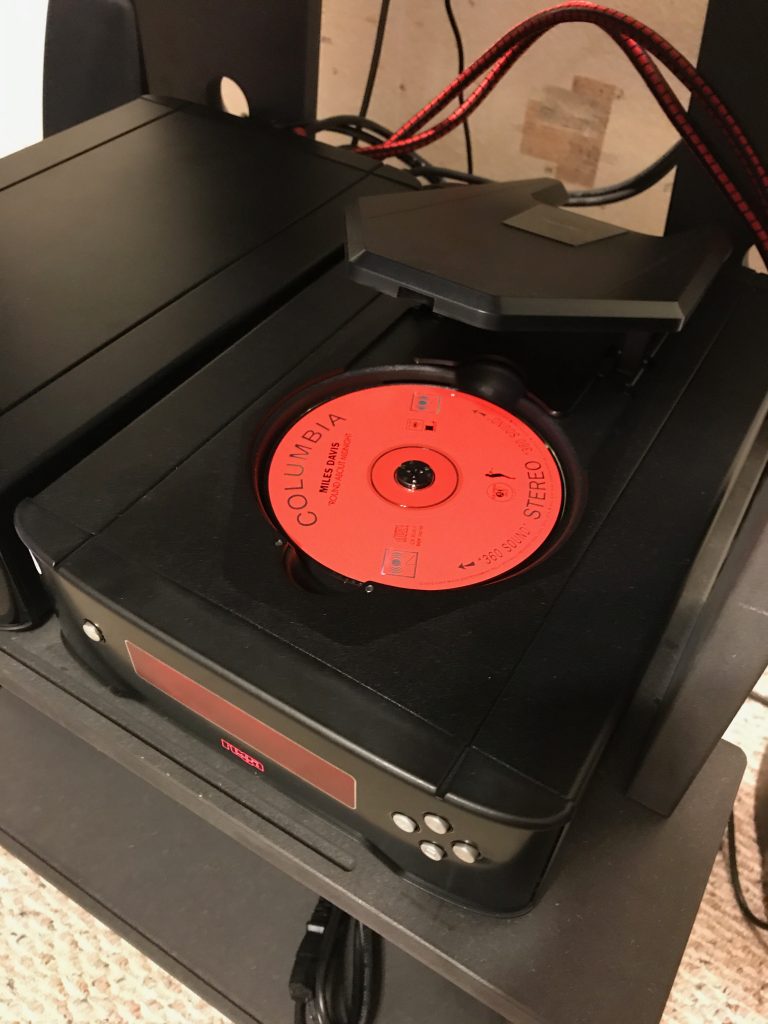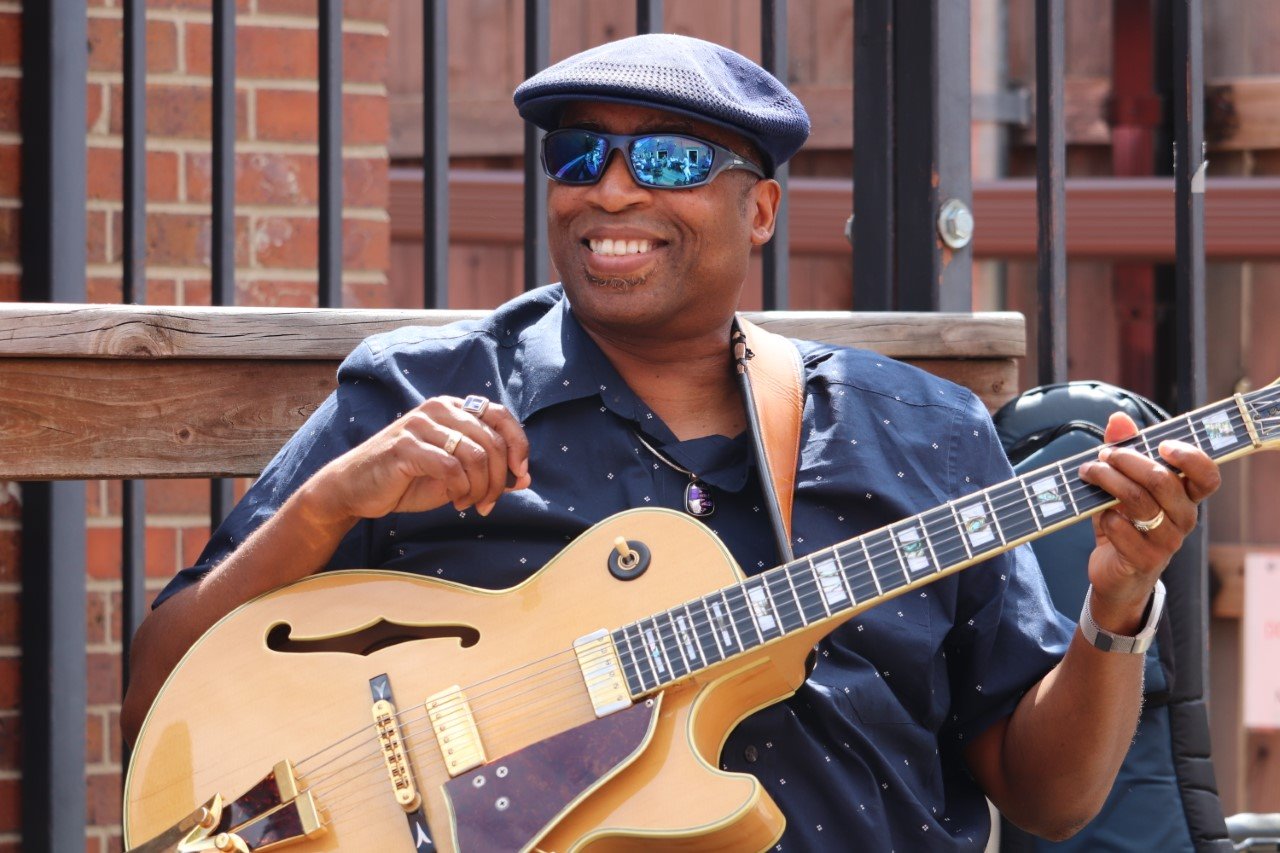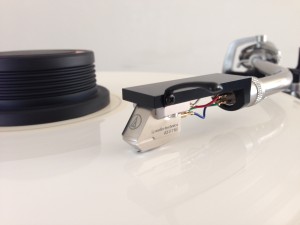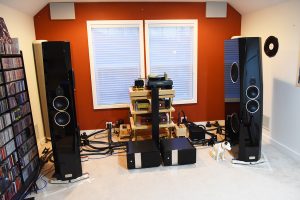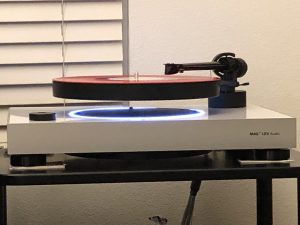Wayne Goins on the hunt for LPs: a selfie!
In my last article for Positive Feedback, I extolled the virtues of the Modwright PH150 and the surrounding components that completed the rig (PS150 power supply; VPI Prime Scout; LTA Ultralinear amplifier and Microzotl amp; Daedalus Audio Athena v.2 loudspeakers; and a complete set of WyWires cables/interconnects. You can read that earlier article HERE. Near the end of the article, I peered into future possibilities that included, among other things, exploring the sonic capabilities of Hana high- and low-output cartridges. I also was interested in learning more about different brands of preamps and just how much they have an effect on the overall sound of a stereo system.
Right around that same time period, Herbert Reichert wrote a great article in Stereophile magazine called "Gramophone Dreams #24: Hana & Musical Surroundings" published on Oct 4, 2018. Herb really was enthusiastic about how awesome the newly released, third-generation Phenomena II+ phonostage (designed by Michael Yee) and its accompanying power supply unit (both made by Musical Surroundings) were paired seamlessly with the Hana SL cartridge (the low-output, Shibata stylus model).
I was intrigued by this article for three reasons: First, I was ready to increase my knowledge and expand my listening experience to go beyond the typical "stereo," and delve a bit deeper into "mono" world. Second, I knew enough to realize that I'd need specific high-grade cartridges to make the music emerge; and thirdly, I enjoyed learning a new term that Herb introduced me to—the dreaded "wall wart," which now meant I needed to avoid that situation and get that Linear Power Supply Unit that Reichert had so soundly praised.
Since I have never purchased a mono cartridge before, I paid close attention when Reichert wrote, and I quote: "I asked Garth Leerer, president of Musical Surroundings, Hana's US importer, if the SL Mono was a true mono cartridge—that is, if it had no vertical compliance and/or generated no signal from its vertical excursions. 'The armature on the SL (stereo) is shaped like an X,' he said. "The SL Mono has it rotated 45° to read only the lateral groove modulation. Hana uses the dual coil to provide multiple ways to interconnect to optimize performance with different systems, as well as dynamically balance the coil/cartridge suspension."
I was happy to hear this news because my original plan was to not only install a Hana cartridge, but also to couple the Phenomena II+ and LPSU to work alongside my Rega components—which currently included the Planar 6 turntable (complete with Neo PSU Power supply and Exacta 2 cartridge), Brio integrated amp, and Apollo CD player. It sounded good on paper.
I quickly looked up the spec sheet about the Hana cartridges and gathered this info from Jerry Raskin's Needle Doctor:
- Stylus: Nude Shibata
- Cantilever: Aluminum
- Output: 2mV
- Output Balance: <1.5dB1KH
- Tracking Force: 2g
- Channel Separation: 25dB/1kHz
- Frequency Response: 15-32,000Hz
- Impedance: 130ohms/1kHz
- Suggested Load: 47k
- Weight: 5g
- Color: Black
- Output: .5mV
- Impedance: 30ohms/1kHz
- Suggested Load: >400ohms
*The SH and SL are identical except for what's specified in the SL section.
Then I read yet another insightful article that sang the praises of the virtues of the Hana cartridges being paired with the Musical Surroundings products. Tom Gibbs wrote "Wolfsong Audio to the Rescue!" published on September 25, 2018 (Issue 99 of our very own PF magazine, which article you can read HERE.) "I then proceeded downstairs to remove and replace the Hana EL cartridge that's been the recent mainstay of my analog playback system," Tom revealed. "The Hana SL (with its Shibata stylus) had recently arrived from Musical Surroundings (Hana's US distributor), and Garth Leerer, my contact there, was totally pumped to have me give the SL a spin. But first, he wanted me to listen to the EL with Musical Surroundings' own Phenomena II+ phono preamp before proceeding to the SL. After a couple of months with the Phenomena II+ in place (amazingly good phono pre, especially at its ridiculously low price point, full review forthcoming), I decided it was time to start breaking in the SL."
Okay, seems to me there's some kind of "mini-movement" going on here, and I'm thinking I might join it; partly because I'd like to be cool and hang out with the big boys, but more important than that, I just wanna acquire knowledge—that's my real drug of choice. So between reading the Reichert and Gibbs articles (two people I greatly admire), suffice it to say my appetite was officially whetted for a Hana/Musical Surroundings combo meal! I rang Tom on the phone; luckily, he was available. We chatted for a good length, and he was enthusiastic, helpful, and supportive of my efforts (if you're reading along with the rest of us, thanks again, TG!)
So now I hereby introduce you to what we will call my "Plan A," which is to get the two MS units and the Hana cartridge to install them on my Rega rig—my overall mission is to see if I can build an a worthy match to compare it to the seemingly indestructible VPI/LTA/Modwright/Daedalus tag team I gloated about in my last article. Let the games begin!
I contacted Nate Lennox at Acoustic Sounds in Salina and purchased the Hana SL Mono cartridge, then set up an appointment whereupon he'd arrive and install it.
I also asked if he'd be willing to show me the two Musical Surroundings units.
But things didn't quite turn out the way I thought they would. Bad news first: Nate hit me with a bit of info that only the more experienced veteran turntable set-uppers might have known about: All the Rega products are, let's just say, "specifically geared and designed" for its own compatibility. Essentially, this means certain "non-Rega" items—like, say, most other cartridges—are absolutely NOT ideal for that RB330 tonearm that's on the Planar 6.
Nate mentioned the fact that the exacta 2 MM cartridge has a headshell that's shallower than normal...
…when compared to the Hana EL, EH, SL, and SH models, which are all physically designed with more depth and width.
Consequently, none of those would work well, because installing them would necessitate a change the angle of the tonearm. Because the Rega cartridges are shallower than the Hana, to make the proper height adjustment, you'd have to raise the arm. And to do that, you need a special "spacer" or "collar" to compensate for it, and…
I'm beginning to think that I'm gonna need the higher-level Rega Aria MC cartridge to improve the sound quality of my Planar 6 turntable, and the Hana SL can't help me now. (What happens to a dream deferred?!) The bad news? My original plan is temporarily thwarted. The good news? I'm learning.
Indeed, it suddenly dawned on me the ingenuity of the design of the uni-pivot that came with the VPI Prime Scout, which has—as on all their current upper-echelon turntables—removable arm wands (JMW 9 for this particular model) that allow you to interchange cartridge setups, so you can switch between name brands either within MM or MC, or alternate between the MM or MC settings to compare the difference in sound quality within the same brands. All you had to do was lift the inverted conical female bearing cup off the male pivot point in order to interchange pre-fitted arm wand assemblies made by VPI.
So I have a Hana cartridge that I now know won't automatically work on a Rega Planar 6 turntable, not to mention that the Rega RB330 three-point fixing arms with non-detachable cables...
...unlike the VPI system—are not designed for easy-access interchangeability…
…nor do they have a removable headshell casing, as in my Technics MKII or Audio-Technica turntables.
I am also faced with a situation where the Phenomena II+ phono preamp and accompanying LCPS unit have already received stellar reviews from two of my stereo review heroes, yet when I tried to integrate some of those same components into my personal setup, it created an overall sound that was less than ideal. It was an eye-opening experience, but not a bad one, because—again—I'm learning!
I'm suddenly realizing that one of the outstanding aspects of Rega's products is that they successfully capture and reflect what might be described as "design synergy," which is, after all, the foundation of all good hi-fi equipment. It doesn't matter how good or expensive a rig is; how the individual pieces perform with one another is what ultimately registers to the listener's ear. I guess on some level I should have expected that—I mean, what else would you do if you were an electronic scientist and acoustical genius like Roy Gandy, who invented a fully-integrated system where he consistently designed every individual component in his shop with superior, unified sound engineering that wouldn't necessarily need to play with anybody else?
So let's summarize the current situation: In my original dream, Nate was initially coming to the house to install the Hana/MS combo on my Rega rig so that I might compare/contrast the results against the sonic capabilities of the ModWright rig, but we know that's not happening. What to do? Well, I'm a jazz musician, so if there's one thing I DO know, it's how to improvise. So, in a flash, a thought occurs to me in the form of a question: The PH150 already has a function that allows the listener to switch between stereo and mono settings, but in the back of my mind, I'm thinking: What's the sonic difference between a "true" mono sound of a low-output MC cartridge (Hana specifically), versus the "mono setting" using the Ortofon 2M Black MM cartridge that came on the VPI Prime Scout turntable? Presto-change-o!! We now have Plan 'B,' and we're half-way back in the "experiential learning" business—for now.
In order to do this, we have to have establish a baseline (with hopefully a nice bass line!) Since I happen to have a freshly bought 180-gram vinyl copy of Chet Baker Plays and Sings…
…we first listened to "I Get Along" which Nate loved immensely (Chet is one of his all-time faves), and then "My Funny Valentine" all set with the "mono" button on the ModWright phonostage using the Ortofon 2M Black. Neither of us had any complaints about the sound emanating from the VPI/LTA/ModWright/Daedulus tag team—we loved every minute of it. Then Nate opens up his tool box and goes to work removing the Black and replacing it with the re-assigned Hana SL mono MC on the VPI Prime Scout turntable.
This was my introduction to the Dr. Feikert Analogue Setup Protractor…
…which, in this case, included a plastic white acrylic disc that had gauges or measurement systems on two sides of the platter: Baerwald, Lofgren, and Stevenson. Nate chose to go with the Lofgren geometry. (Note: there is a newer model out now—Dr. Feickert Universal Protractor—which Nate says is a much easier and more precise tool.
While switching out the cartridges, we noticed immediately that the Hana cartridge was lighter in weight than the 2M, so we adjusted the tracking force.
For these next steps , we take the felt VPI turntable mat off the plinth, so that we don't get false measurements while we aim for precision. Then, using the Lofgren scale, we adjusted and set the proper overhang to 224…
We then adjusted the cartridge orientation (the angle)…
Now we do tracking force (we want 2 grams, which is what Hana recommends; we started with 2.3 which was not bad, so we adjusted the counterweight to 1.9 which is, in Nate's words, "close enough!"
Using the mm. gauge, we adjust the cartridge azimuth…
Again using the mm. gauge that Nate handily has on the backside of his business card, we then adjust the arm height (we put the felt mat back on for this part)...
...and Nate noticed that it was cranked way up in the back, so he loosened the two locking collar screws...
...and lowered the entire arm wand. (He also removed the fishing line because it was no longer needed from the last visit when he detached the anti-skating device.)
So now we start "earballing" (as Nate terms it), and just use our God-given tools to see whether there is a good tone, balance, black background, etc. We left the mono button in the 'off' position, and played again the Chet Baker music, which didn't sound too severely different from the "mono" button setting—a strong point for the Dan Wright camp!
Nate then did about an hour of multiple mini-adjustments, which we had come to expect by now (he is extremely meticulous about this process, and for good reason!).
Our first pass at the Miles Davis Quintet Round About Midnight LP was a bit stiff—the way it sounded to me was that while the trumpet was sooo crystal clear and present (as if Miles was in my living room sitting in chair playing into a microphone at my ear level), but the acoustic bass of Paul Chambers sounded pushed farther back. The drums are at Paul's stage right, and Red Garland's piano, sonically speaking, sounded as if it was sitting in a closet in a totally different room in Studio D of the Columbia Records facility on 30th St in New York City.
This, of course, cannot be right—can it? I mean, we spent so much time calculating that delicate balance between the cartridge's azimuth and the overhang and the this and the that—you know the dance where the first thing is correct but the third one is obviously not, until you get that second thing right—which, in turn, affects that first thing? Yeah, THAT dance. We were really tweaking to make this Hana cartridge speak to us.
So as a general point of reference, I decided to revert briefly to the CD version of the 'Midnight' album. I found the disc and played it in my Apollo on the Rega rig.
Sure enough, that's where they'd mixed the piano—and for some reason, it's the only tune on that album where they mixed it that way—and I'm still not sure why they (producer George Avakian, engineer Frank Laico, and Teo Macero who mastered the album) allowed that to happen. Meanwhile, on that title track the bass is speakin' to me, Coltrane's tenor is beautiful, and I cannot say enough about the snare and hi-hat and ride cymbal from the drums of Philly Joe Jones.
Because of the relatively lower output of the Hana SL, I wasn't used to setting the volume on the LTA preamp on numbers that ranged from 45-52. But increasing these numbers only slowly pushed all the music forward toward my cranium, and in the sweetest way. Sound came flowing evenly across the board. It really made me appreciate the relationship between the speakers and the turntable and the preamp—nothing was distorted, in even the slightest manner. I pushed up to 57—things only got better, clearer, and oddly enough, softer and rounder—it was like sonically defying gravity!!. And it was during this time period that the last track on the second side, "Dear Old Stockholm," was swingin' like maaaad.
But I'm getting ahead of myself: "Bye Bye Blackbird" has Coltrane's tenor sax bursting forth even more prominently than warm muted trumpet of Miles. Meanwhile, the steady swinging drums of Philly Jo are just smoothly percolating in the background, his pinging right-hand ride cymbal, the steady clip of the high-hat on two-and four-, and the crisp, light intercepting jabs of the snare. Then there was such clarity and articulation of Red's piano solo, especially when he shifts to the locked hand Bill Bruckner chord solo that he as well as Oscar Peterson, Ahmad Jamal, and the inimitable George Shearing mastered. When "Tadd's Delight" comes on, it's almost a perfect example of how to test a cartridge's ability to speak. Listen to Jones, who does the snare "ruffs" on the melody, then goes into a brisk swing groove, then does the side-stick rimshot knocking at the beginning of Miles second chorus! And let's not overlook the three other layers of sound: The warmth of Miles and Coltrane's tone, contrasting the thick warm bass while punctuating piano chords sit comfortably in between. The piano moves forward so seamlessly when Garland's time to shine arrives, and you can literally hear the separation of his left and right hand—he accents certain notes (masterful phrasing/articulation) in his right hand, while he pads more gently with the three-note voicings in his left hand. And on 'Stockholm,' the bass solo is boomy without being blurry, while the punctuation of the piano chords is simply sparkling.
Oh, I could go on and on, but why? You already know what the rest sounds like. Nate did a wonderful job installing this Hana cartridge—it's soooo nice. I listened again to the Miles Ahead album (my ultimate favorite orchestral affair between Gil and Miles)...
...and you can hear all the reverb in the room that it was recorded in—this achievement was a difficult thing to achieve with that huge orchestra. Yet, the "Springsville" background jabs of the trumpet section contrasted beautifully from the rhythm section—and you can somehow still hear the '2' and '4' hi-hat (as well as ride cymbal) slicing right through the entire orchestra, which was no small engineering feat! The "Maids of Cadiz" was so luscious from top to bottom, and it made you feel as if you were sitting in the session, especially when Miles temporarily stepped aside and let the singular orchestral genius of Gil Evans kick in on the chorus portion of the arrangement. During this interlude, you can hear the hi-hat and the literal brush in the right hand of Jimmy Cobb play against the brief bass solo of Mr. P.C. And when "The Duke" kicks in, it's so luscious and juicy—Cobb's drums cut through even clearer. When Miles takes his solos, the bass and drums are speaking in an exceptionally articulate manner. The background riffs of bones and trumpets are not brittle or harsh, just forward and massive in intensity. In all the quiet spots (like the transitional material Gil wrote in between the end of "My Ship" and the beginning of "Miles Ahead,") it sounded like one of the most beautiful things I have never heard.
"Blues for Pablo" (last song on side 1) is just incredible—the milky-warm flugelhorn of Miles against the glistening, golden shouts of the bones, trumpets, French horns, tubas, and clarinets. This joyful noise temporarily gives way to an interlude using the flute, only to be blasted out by the trumpets on the intro of "New Rhumba." Hint: the stop-time section can really tell you whether you got things set right with your cartridge setup. Listen for clarity of the muted trumpet section against warm trombones, and French horns against clarinets and flutes, while Miles floats above and through it all as he interjects his flugel love. Then the band goes into an up-tempo walking swing, and you can hear that killer '2 and 4' from Cobb again as P.C.'s bass walks like crazy—it's amazing how you don't even miss a piano—Gil uses the horns for all that. When the PC bass solo comes in at the end, its razor-laser sharp and articulate.
Ultimately, I decided that if we were gonna put other versions of Hana cartridges on the VPI, then I needed to find an entirely new and separate tonearm so that I could go between true mono and stereo cartridges at ease by just switching out the arm units as I took advantage of the Uni-pivot system. I have to remind myself, however, that this Prime Scout doesn't actually belong to me, and that it's living on borrowed time [I know I have to return it at some point!], so I should reconsider how much I should invest in the future of its life with me.
Once we finished with the VPI setup, we re-focused our attention on the Rega rig, which was initially what Nate had come there for. We had already learned that the Hana cartridge wasn't an option for this setup, and now were faced with the notion that when Nate opened the two boxes and hooked up the Musical Surroundings components, what we heard somehow didn't quite sound as good as what the Rega MM/MC integrated amp was already providing. Maybe we didn't have the left and right gain or input loading dip switches set right on the back of the Phenomena II+ unit—maybe the cartridge should have been a higher quality than the standard Exacta 2. Clearly there was more experimenting to be done! Nate was even surprised and said he learned quite a bit from that experience as well (he later conferred with his mentor Chad Stelly, who intimated that the problem was more likely something we did, and not in any way a reflection of the Phenomena II+, a notion of which I had no problem personally accepting on my part, being the novice that I am!)*
*[In fact, days later, while I was cruising the internet still searching for info, I found this on the audio advice website while looking at some Sutherland brand preamps: "Just about every single phono stage on the market that can handle a MC cartridge can also work with an MM cartridge. You will usually see a little switch to change between the two. If you were to connect a MC cartridge to an MM phono stage, the sound would be ok, but probably not loud enough. However, if you connect an MM cartridge to a MC phono input, the sound will probably be distorted."
Yup—sounds just like what we experienced.
My initial reaction was to be despondent over the distorted interaction between the components. But wait—after spending a couple of nights thinking about this unexpected dilemma, a thought hit me like a lightning bolt— the solution to all of it was right there in front of me. I remembered that my initial plan was to mainly get rid of the "less than 200 bucks" Micromega Mygroov preamp. It was the first preamp I'd ever invested in buying, but it had long-since served its purpose when I first started writing for this magazine over a year ago. At the rate I was learning, I soon grew out of it without even realizing it, as my instincts started kicking in telling me to find a way to step up my game.
This, at the outset, is where the Phenomena II+ idea came into play in the first place! But now that the Phenomena II+ and the accompanying Linear Charging Power Supply initially didn't seem to exude instant chemistry with the Rega rig (again, very likely my fault), I came up with a great alternative: What if I purchased the one item missing from my Rega rig—the Aria MM/MC Preamp??
It made perfect sense—it has totally independent MC and MM stages, not to mention the added bonus of the ability to run a separate turntable through the unit! This is exactly what I need to do A/B comparisons between mono and stereo LPs. Using yet another Rega product that was built for the very system I already own, my "compatibility" problems were obviously now a non-issue! I'd soon have a Brio integrated amp, Apollo CD player, Aria MM/MC Preamp, Planar 6 turntable—with an option to add my Technics turntable on an adjacent stand with a permanently set mono cartridge attached to a removable headshell. Oddly enough, the Aria cost almost exactly the same amount as the combined cost of the two Musical Surroundings units, so it was almost an even swap. Hello—it's 'Plan C'!!!
Then I thought, "well, hell, why not go for broke?—If I'm investing in building the ultimate Rega rig, I may as well get a higher grade cartridge than the Exacta 2 (an MM). I hadn't yet heard an MC on the Planar 6, and was looking forward to a heightened experience that Rega promised in all their ads. This, of course, led me further away from the Hana models and toward the Rega Ania cartridge (not to be confused with Aria, which is they named the preamp).
Even though I'd somehow managed to live to fight another day, I promised myself, the "Phenomenal" experience, no doubt, would come eventually. But for now, my finally completed Rega rig looks like this:
Dare I say, 'Plan D' is in effect—and time will tell if this was the true path to sonic enlightenment. This looks like a great excuse for a next article, so tune in next time when I share with you another great chapter in my "Experience."
Until then, keep on swingin'!
All photographs by Dr. Wayne Goins, unless otherwise indicated.





























